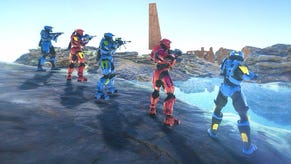Halo: Reach beta footage analysis
Digital Foundry runs frame-rate tests.
The latest Halo: Reach developer diary gears up nicely for the imminent launch of the multiplayer beta, and its eight-minute duration offers up an excellent array of action for us to consider.
The game's visual make-up is similar to that of its predecessor: a mixture of indoor and outdoor environments, with the latter looking considerably more impressive than the former. The resolution boost over Halo 3 is immediately obvious though, as are the truly impressive lighting and particle effects.
Texture filtering also looks much improved (better than the alpha footage we saw in the first developer diary, in fact, though maybe this is down to the clip selection), and one of the most dramatic improvements is in the motion blur: far more apparent and more realistic. A nice subtle effect is some camera shake when there's an explosion. Also apparent is the inclusion of screen-space ambient occlusion (SSAO), though its impact is subtle.
Onto performance then. We couldn't resist running the three minutes of in-game Reach video through our analysis tools, and this is what we discovered.
It's important to note that there are distinctions to be made when running internet video through our tools compared to our own "home-made" captures. Most crucially, downloaded video is almost always 30FPS rather than the 60FPS of our own stuff. What this means is that if a game runs faster than 30FPS, the results will not be accurate should frame-rate go higher (blending artifacts from one frame to the next in some of the clips suggest it tops out at 30FPS, but we'll check that for sure once we have the beta ourselves).
Also, without the full video output of the console available, tear analysis isn't possible. From the look of the footage thus far, it appears that Reach does tear, but only rarely.
The other issue is compression. Duplicate frames aren't 100 per cent identical in compressed footage as they are in our own lossless captures, so we need to find the new threshold and then manually check these frames. Time-consuming, but essential for accuracy.
The results? Similar to Halo 3, Reach performs admirably in maintaining 30FPS. Similar to our last analysis of the alpha footage, we do see the occasional, pretty severe drop down to 20FPS. However, the vast majority of these drops appear to be occurring outside of the first-person perspective, so maybe not a part of the gameplay experience. Perhaps it's a spectator camera? We'll find out for sure shortly when we get hands-on.









